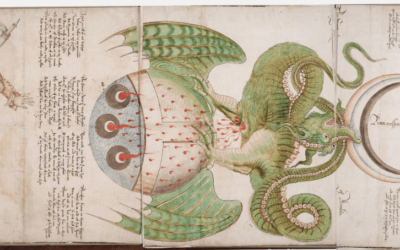
What does Magenta Mean in a Dream?
Magenta, a captivating and enigmatic color, occupies a unique place in the spectrum of human perception and experience. Not found in the traditional sequence of visible light, magenta arises from the combination of red and violet wavelengths at opposite ends of the spectrum. As the last color humans evolved to perceive, magenta engages more recently developed and integrative brain networks, hinting at its profound capacity to promote emotional healing, self-acceptance, and spiritual transformation.
Magenta in Dreams: Symbols of Emotional Integration and Spiritual Awakening
In the realm of dreams, magenta often appears as a symbol of emotional healing, wholeness, and spiritual transformation. When magenta colors appear in a dream, they may indicate a process of integration and reconciliation taking place within the psyche, a coming together of disparate parts of the self into a more coherent and harmonious whole.
Magenta dream symbols often take the form of objects or figures that embody the union of opposites, such as a magenta rose that blends the passion of red with the purity of white, or a magenta sunset that bridges the boundary between day and night. These images suggest a movement towards balance, a letting go of dualistic thinking and a willingness to embrace the full spectrum of human experience.
Magenta in dreams may also be associated with the archetype of the Great Mother, the unconditionally loving and nurturing presence that provides a sense of safety, comfort, and emotional support. Dreaming of being held or surrounded by a magenta light may indicate a need for self-care, compassion, and emotional nourishment, or a desire to return to a state of childlike innocence and trust.
On a spiritual level, magenta dreams may signify an opening to higher states of consciousness, a connection with the divine feminine, or a call to embark on a journey of self-discovery and spiritual growth. Magenta mandalas, yantras, or sacred geometrical patterns in dreams may represent the unfolding of the soul’s potential, the blossoming of inner wisdom and intuitive understanding.
When working with magenta dream symbols in therapeutic or personal growth contexts, it is important to approach them with an attitude of openness, curiosity, and non-judgment. By exploring the feelings, associations, and insights that arise in connection with these symbols, individuals can gain valuable insights into their emotional landscape, their relationships, and their spiritual path.
Some practices for working with magenta dream symbols include journaling, creative expression, and guided imagery. By drawing, painting, or sculpting the magenta images that appear in dreams, individuals can bring them into the waking world and engage with them more deeply. By dialoguing with magenta figures or objects in a dream, either through written reflection or active imagination, individuals can access the wisdom and guidance they offer.
Ultimately, the appearance of magenta in dreams is an invitation to embrace the fullness of our being, to integrate the shadows and the light, and to open our hearts to the transformative power of love and compassion. By honoring these messages from the depths of our psyche, we can move towards greater wholeness, resilience, and alignment with our true nature.
Magenta in Emotional Transformation Therapy: Somatic Healing and Integration
In the practice of Emotional Transformation Therapy (ETT), magenta plays a crucial role in facilitating somatic healing, emotional regulation, and the integration of past experiences. As a soothing and stabilizing color, magenta is often used at the end of a session or between different stages of emotional processing to help ground and recenter the client.
On a physiological level, exposure to magenta light in ETT has been found to promote parasympathetic nervous system activation, slowing down the heartrate, deepening the breath, and creating a sense of calm and relaxation in the body. This shift towards a more regulated state helps to counterbalance the intense or overwhelming emotions that may arise during trauma processing or deep emotional work.
Magenta is also believed to have a gentle energizing effect on the body, particularly on the heart and circulatory system. By stimulating the flow of blood and life force energy, magenta can help to release physical tensions, blockages, or areas of numbness and disconnection. This increased vitality and aliveness in the body can support the process of embodiment, the capacity to feel and inhabit one’s physical being fully.
Throughout the different stages of ETT, magenta can be used to help integrate and consolidate the insights, emotional shifts, and somatic experiences that emerge. After a period of intense processing or release, taking a few moments to bask in magenta light or to visualize a magenta mist enveloping the body can help to soothe the nervous system, settle the mind, and create a sense of closure and completion.
As clients become more attuned to the presence of magenta within and around them, they can begin to internalize this felt sense of safety, nurturance, and wholeness. They may find that simply calling to mind the color magenta or visualizing themselves in a magenta bubble of light can help to regulate their emotions, ground them in their bodies, and connect them to a deeper source of inner wisdom and resilience.
Ultimately, the somatic experience of magenta in ETT is an invitation to come home to ourselves, to rest in the spaciousness and tenderness of the heart, and to trust in the body’s innate capacity for healing and transformation. By anchoring our awareness in the soothing, integrating energy of magenta, we can navigate the ebb and flow of our emotional world with greater ease, resilience, and grace.
Therapeutic and Transformative Applications of Magenta
Activating Integrative Brain NetworksUnlike other colors that stimulate specific combinations of cone cells in the retina, magenta requires the activation of both long-wavelength (L-cones) and short-wavelength (S-cones) photoreceptors simultaneously (Gegenfurtner & Kiper, 2003). This unique combination engages a constellation of integrative brain networks that span subcortical and cortical regions, promoting emotional awareness, regulation, and the synthesis of diverse streams of information.
One key hub activated by magenta light is the anterior insula, a region involved in interoception, emotional awareness, and the integration of somatic and cognitive states (Craig, 2009). The anterior insula works in close synergy with the anterior cingulate cortex (ACC) to form a salience network that detects and responds to emotionally relevant stimuli (Menon & Uddin, 2010). fMRI studies have shown that magenta strongly activates these regions, suggesting its role in enhancing emotional awareness and facilitating the integration of sensory, affective, and cognitive information (Santos et al., 2014).
Magenta also engages higher cortical areas involved in self-referential processing, autobiographical memory retrieval, and meaning-making, such as the medial prefrontal cortex (mPFC) and the posterior cingulate cortex (PCC) (Northoff et al., 2006). These regions, part of the default mode network (DMN), are active during introspection, contemplation, and the integration of personal experiences into a coherent narrative identity (Raichle, 2015). By enhancing the connectivity between the DMN and memory-related areas like the hippocampus and retrosplenial cortex, magenta may facilitate the recall and recontextualization of significant life events, promoting narrative integration and emotional healing.
Balancing Arousal and Transcendence
At a deeper level, magenta’s unique combination of red and violet wavelengths allows it to bridge the passionate, energizing qualities of red with the calming, transcendent energy of violet. This dynamic balance is reflected in magenta’s effects on the hypothalamus, a region that regulates primal drives, emotional responses, and physiological arousal (Vandewalle et al., 2010).
While red light tends to increase hypothalamic activity and promote a state of heightened excitement and alertness, violet light has a more calming and stabilizing effect on the hypothalamus. Magenta, by engaging both the stimulating and relaxing aspects of these colors, may help to balance arousal levels and create an optimal state for emotional processing and integration.
This modulating effect of magenta is further supported by quantitative EEG studies, which have shown that magenta induces relatively high alpha wave activity across posterior and frontal regions (Yuda et al., 2019). Alpha waves, associated with relaxation combined with gentle alertness, align with subjective reports of magenta being both calming and mildly energizing, promoting an adaptive state for deep emotional work.
Facilitating Emotional Processing and Integration
The neurobiological mechanisms underlying magenta’s ability to facilitate the completion of emotional arcs and release deep-seated emotions may be related to its integrative effects on the brain. By simultaneously activating regions involved in emotional awareness (insula), regulation (mPFC), and integration (cingulate), magenta creates a neurological context conducive to processing and resolving complex emotional experiences.
Moreover, magenta has been found to evoke strong event-related potentials (ERPs), particularly the P300 component, which reflects the engagement of attention and cognitive resources (Yuda et al., 2017). The high P300 amplitude elicited by magenta suggests that it effectively captures attention and enhances the emotional salience of stimuli, deepening the impact of therapeutic experiences.
Recent fMRI research has further illuminated the neural correlates of magenta’s emotional effects. A study by Kreplin and Fairclough (2013) found that viewing magenta, compared to neutral gray, significantly increased activation in the amygdala, a key emotion processing center that interacts with the cingulate, insula, and prefrontal cortex to regulate emotional responses (Pessoa, 2017). Magenta’s engagement of this limbic network may underlie its capacity to access and integrate deep-seated emotions.
An ERP study by Sarlo et al. (2012) provided additional evidence for magenta’s impact on emotional processing, revealing larger late positive potentials (LPPs) in response to magenta compared to neutral stimuli. The LPP, an ERP component indexing sustained attention to emotionally salient stimuli (Hajcak et al., 2010), suggests that magenta effectively engages attentional and motivational resources to promote deeper emotional processing and integration.
Taken together, these findings paint a picture of magenta as a powerful facilitator of emotional healing and wholeness. By engaging a constellation of integrative brain networks that bridge primal emotion centers with higher cortical areas, magenta helps to release chronic tension, promote self-awareness, and weave the threads of personal experience into a coherent, meaningful narrative. As we continue to explore the transformative potential of this color, let us keep in mind its unique capacity to balance and harmonize the diverse aspects of the human psyche.
The Symbolism and Archetypes of Magenta
Beyond its neurobiological effects, magenta carries a rich tapestry of symbolic and archetypal meanings that have shaped human experience and imagination across cultures and throughout history. From ancient myths and spiritual traditions to modern art and literature, magenta has been imbued with a profound significance, reflecting its power to evoke the mysteries of emotional healing, wholeness, and spiritual transformation.
The Union of Opposites and the Path of Wholeness
One of the most fundamental symbolic associations of magenta is its representation of the union of opposites, the integration of seemingly disparate or conflicting elements into a harmonious whole. As a color that arises from the blending of red and violet, the two extremes of the visible spectrum, magenta embodies the principle of coincidentia oppositorum, the coincidence or unity of opposites (Jung, 1959).
In many spiritual and philosophical traditions, the reconciliation of opposites is seen as the key to enlightenment, self-realization, and the attainment of ultimate truth. In Taoism, for example, the interplay of yin and yang, the primordial feminine and masculine principles, gives rise to the diversity of the manifest world, with their harmonious balance leading to the experience of the Tao, the ineffable source of all being (Fowler, 2005). Similarly, in Jungian psychology, the integration of the conscious and unconscious aspects of the psyche, the light and shadow sides of the self, is essential for the process of individuation and the emergence of the transcendent function that unites the opposites (Jung, 1959).
Magenta, as a symbol of this alchemical marriage, invites us to embrace the full spectrum of our being, to reconcile the polarities within ourselves and in our relationships with others. It encourages us to transcend dualistic thinking, to find the middle path between extremes, and to discover the underlying unity that encompasses all of existence. By working with the energy of magenta, we can learn to hold the tension of opposites, to navigate the challenges of paradox and ambiguity, and to cultivate the wisdom and compassion that arise from a more integrated and holistic perspective.
The Divine Feminine and the Mysteries of the Heart
Another significant symbolic association of magenta is its connection to the divine feminine, the archetypal principle of receptivity, nurturance, and unconditional love. In many cultures, the color pink or magenta is linked to the female deities, such as the Hindu goddess Lakshmi, the Greek goddess Aphrodite, or the Virgin Mary in Christian iconography (Biedermann, 1994). These figures embody the qualities of compassion, tenderness, and the transformative power of love to heal and uplift the human spirit.
Magenta, with its soft, soothing, and enveloping presence, evokes the energy of the divine mother, the cosmic womb that births and sustains all of creation. It reminds us of the primacy of the heart, the seat of our deepest emotions, desires, and connections to others. By attuning to the magenta ray, we can access the infinite well of love and compassion that resides within us, the inner sanctuary where we can find solace, renewal, and the courage to face the challenges of life with an open and resilient heart.
In the tantric traditions of Buddhism and Hinduism, magenta is associated with the heart chakra, the energetic center that governs our ability to give and receive love, to experience joy and gratitude, and to connect with the inherent goodness and beauty of all beings (Judith, 2004). By meditating on the magenta light of the heart chakra, we can awaken our capacity for empathy, forgiveness, and unconditional positive regard, both for ourselves and for others. We can learn to embrace our vulnerability, to honor our emotional truths, and to radiate the healing presence of love into the world around us.
The Spiritual Androgyne and the Transcendence of Duality
At its deepest level, magenta symbolizes the spiritual androgyne, the divine hermaphrodite that embodies the perfect balance and integration of masculine and feminine principles within the self. In many esoteric and mystical traditions, the androgyne represents the state of spiritual perfection, the return to the primordial unity that existed before the differentiation of the sexes and the emergence of duality in the world of form (Eliade, 1962).
In alchemical symbolism, the divine androgyne is often depicted as a being of radiant light, with one half of the body colored red (masculine) and the other half colored white or violet (feminine). The union of these opposites in the alchemical marriage gives birth to the philosopher’s stone, the embodiment of enlightenment, immortality, and the transmutation of base matter into spiritual gold (Jung, 1963). Magenta, as the synthesis of red and violet, represents the realization of this alchemical ideal, the attainment of a higher state of consciousness that transcends the limitations of the ego and the dualistic mind.
By contemplating the magenta light of the spiritual androgyne, we can connect with our own inner wholeness, the sacred marriage of the masculine and feminine aspects of our psyche. We can learn to balance the active and receptive, the assertive and yielding, the rational and intuitive dimensions of our being, and to embody a more fluid and integrated sense of self. As we dissolve the barriers between the polar opposites within us, we begin to experience the underlying unity and interconnectedness of all life, the nondual awareness that is the true nature of our being.
Therapeutic and Transformative Applications of Magenta
The insights gained from the neuroscience and symbolism of magenta have profound implications for therapeutic practice and personal transformation. By consciously working with the energy and meaning of magenta, therapists and individuals can tap into its potent capacity for emotional healing, self-integration, and spiritual awakening.
Emotional Healing and the Completion of Emotional Arcs
One of the primary therapeutic applications of magenta is its ability to facilitate the resolution of emotional arcs, the completion of unfinished emotional business that can keep individuals stuck in patterns of suffering and self-limitation. As Dr. Vazquez (2014) observes, magenta has a unique property of helping to ground and stabilize clients who are overwhelmed by intense emotions, allowing them to process and release the underlying feelings in a safe and contained way.
In the context of Emotional Transformation Therapy, magenta is used after each color in the spectrum to help the brain integrate and resolve the emotional arcs activated by that particular hue. This process allows clients to revisit and reframe past experiences, to release trapped emotions, and to find new meaning and perspective in the challenges they have faced. By bathing in the soothing and stabilizing light of magenta, clients can learn to befriend their emotional experience, to develop greater self-compassion and acceptance, and to cultivate a more secure and resilient sense of self.
Magenta can be particularly helpful for working with attachment wounds, early relational traumas that can leave individuals feeling disconnected, anxious, or avoidant in their intimate relationships. By providing a safe and nurturing space for exploring these wounds, and by modeling the unconditional love and acceptance of the divine mother archetype, therapists can use magenta to help clients develop a more secure and trusting relationship with themselves and others. Through this process of emotional healing, individuals can begin to let go of the defensive patterns that keep them isolated and unfulfilled, and to open their hearts to the possibility of genuine intimacy and connection.
Self-Integration and the Embodiment of Wholeness
Another key therapeutic application of magenta is its capacity to promote self-integration, the process of bringing together the disparate parts of the self into a more coherent and harmonious whole. As a color that represents the union of opposites and the reconciliation of polarities, magenta can be a powerful tool for helping individuals to embrace and integrate the shadow aspects of their psyche, the disowned or rejected parts of themselves that they have kept hidden from conscious awareness.
By working with the energy of magenta, therapists can create a safe and nonjudgmental space for clients to explore their shadow material, to confront the parts of themselves that they have deemed unacceptable or unlovable, and to begin the process of self-acceptance and self-integration. This may involve practices such as inner child work, psychodrama, or art therapy, which allow clients to give voice and expression to the buried aspects of their psyche, and to find new ways of relating to themselves with compassion and understanding.
As individuals begin to integrate their shadow, they may experience a greater sense of wholeness, authenticity, and vitality, as the energy that was previously trapped in self-rejection and internal conflict is liberated and made available for growth and self-expression. They may also find that they are able to relate to others with greater empathy and understanding, as they recognize the common humanity that underlies the diversity of human experience.
Spiritual Awakening and the Path of Self-Transcendence
At its deepest level, magenta can be a powerful catalyst for spiritual awakening and self-transcendence, the recognition of our essential unity with the divine and the realization of our true nature as boundless awareness. As a color that represents the highest levels of spiritual attainment and the union of the individual soul with the cosmic source, magenta can be a valuable tool for supporting individuals on the path of spiritual growth and transformation.
By meditating on the magenta light of the crown chakra, or by visualizing oneself as a radiant being of magenta light, individuals can cultivate a state of expanded awareness, inner peace, and alignment with the universal flow of life. They can learn to let go of their attachment to the ego, to surrender to the mystery of existence, and to trust in the inherent wisdom and intelligence of the cosmos.
This process of spiritual awakening through magenta may involve practices such as contemplative prayer, chanting, or deity yoga, which help to focus the mind, open the heart, and attune the individual to higher frequencies of consciousness. It may also be supported by the use of magenta-colored crystals, such as rose quartz or rhodonite, which are believed to carry the vibration of unconditional love and emotional healing.
As individuals awaken to their true nature through the magenta ray, they may experience a profound sense of liberation, joy, and connection to all of life. They may discover a deep well of inner strength, resilience, and creativity, and feel called to share their unique gifts and talents in service of the greater good. By embodying the wisdom and compassion of the spiritual heart, they can become a beacon of hope and healing for others, and contribute to the evolution of human consciousness.
Color Psychology






















0 Comments